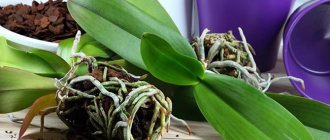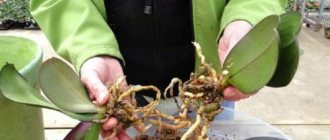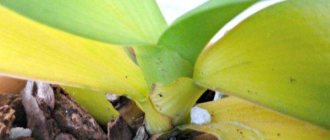How to understand when it's time to water an orchid
The substrates used for orchids are usually heterogeneous, and it is difficult to determine from their appearance whether the plant needs to be watered.
But there are other signs:
- Weight of the pot. If it has become too light, then most likely the flower has been thirsting for moisture for a long time. To make it easier to navigate by this sign, you need to pick up the pot after watering and feel its weight. After a few days, you need to check his weight again. If you feel significant weight loss, you should water.
- Check soil moisture with your finger. You need to push away the top layer of soil and dig into the remaining soil with your finger. If it is dry, then you need to water it.
- Insert a wooden stick. It is advisable to do this immediately after watering, and then simply pull it out periodically and see whether the wood at depth is dry or wet.
- Orchids are usually planted in transparent pots, so condensation is clearly visible on their walls. If it has disappeared, then it is necessary to carry out irrigation procedures.
- The roots are also visible through the transparent walls of the flowerpot. When their color changes from green to silver, as well as when a loss of elasticity is detected (they become wrinkled), they need to be watered.
- If the roots lose their elasticity, the leaves also become sluggish and droop.
- If there is a lack of moisture, a flowering plant will begin to drop flowers.
Is it necessary to do it?
Do I need to water? You cannot do without watering; different watering schemes are recommended, depending on the nuances of transplantation.
Two main reasons:
The soil for orchids is special. The soil is loosely poured into the pot, so it is able to retain moisture only for a short period. The soil becomes compacted within a month and begins to retain moisture longer.- Since there is little soil, its hygroscopicity in relation to the introduced moisture is low and therefore it is easy to flood the orchid at this time, causing rotting of the roots and leaves.
How many times and how often should the procedure be performed?
The irrigation schedule depends on a number of indicators:
- temperature;
- air humidity;
- lighting;
- dimensions of the flowerpot;
- seasonality.
In general, it is believed that in summer a flower should be watered 1–3 times every 7 days, and in the cold season, when the plant is dormant, 1–2 times a month.
It is recommended to carry out the procedures in the morning. Important! In the absence of irrigation for a long time, the flower should be restored by watering from the shower.
What should you not do at this time?
Common mistakes that gardeners make when watering orchids:
- Excessive or too frequent watering. Do not go to extremes, focus on the condition of the flower and the substrate.
- If you doubt whether it is possible to add fertilizers in the first month after transplantation, the answer will be negative; it is better to use specialized means for root growth, for example Kornevin.
- After irrigating using any of the methods, monitor the accumulation of moisture in the axils of the leaves.
- Do not leave the transplanted orchid in a place that is brightly illuminated by the sun.
- For irrigation, use filtered or settled water (read about what kind of water to use and what you can use to water orchids here).
Watering orchids is an important aspect of plant care. It is important to know not only about watering after transplantation, but also during flowering.
How to properly water an orchid after transplantation at home
It is not recommended to irrigate the orchid immediately after transplantation. It is advised to wait a week or two so that the plant can take root, of course, only if the reason for replanting is not the death of the roots after a long period of drought. Then you need to moisten the substrate a little. Irrigation activities can be carried out using one of the methods described below.
Dive
To implement this method, it is necessary to prepare a basin with water at a temperature of +20...+32°C. Before doing this, the container must be doused with boiling water. The pot is slowly immersed in water so that the water rises to the very top. It is held in this position for 1–2 minutes, then slowly rises and is left suspended for the same time so that excess water drains away.
For each flower, fresh water is collected, and the basin is doused with boiling water. This method is most often used when keeping the plant cool. It is quite effective and does not take much time.
Important! You can use immersion technology only if you are sure that the plant is not sick and the substrate is not affected.
Watering from above
Watering from above can be done using a watering can or spray bottle (spraying). You need to take a plastic watering can, since metal does not interact well with the roots of the flower. The pressure when watering should be weak, it is best to pour along the edge of the pot so as not to touch the sinuses and growing points. Water should be poured until it appears in the pan. Excess moisture is drained and the action is repeated after a few minutes. This method is ineffective because the soil is moistened unevenly.
Spraying with a spray bottle is also an ineffective method. It is more suitable for increasing air humidity. Warm water is used and the orchid is thoroughly sprayed with it for 20 seconds. Then take a short break and repeat the procedure again. In 30 minutes you need to do 3 irrigation procedures at equal intervals. After the shower, moisture is removed from the leaves and axils.
Running water
This type of watering will simulate rain. It is the most effective among all, since it saturates the flower with oxygen. Running water must be run through the shower. This will not only irrigate the plant, but also cleanse its foliage of parasites.
Did you know? Orchid flowers that are cut and placed in a vase stay fresh much longer than any other flower.
Flower pots should be placed in the bathroom and watered with low pressure of warm water (+40…+50°C) through the shower head. The water should completely moisten the substrate. After this, the plants are left for 20 minutes to drain off excess moisture. Then, after another 40 minutes, the leaves and shoots are wiped with a napkin.
Spraying the roots
This technique is used when a flower is grown without a substrate. When the root system dries, it is sprayed with warm water from a spray bottle until it again acquires a green tint. The next irrigation procedure is carried out when the roots lighten.
Important nuances
If almost all the roots of an orchid have been removed and the leaves have been cut off, then there can be no talk of regular watering or transplantation; a special resuscitation regime is required until it forms a new root system. Watering by soaking is unacceptable here.- It is preferable to water with fertilizing after the plant begins to grow; this is the best option, although there are gardeners who have a different opinion and feed the flower while soaking.
- You should not leave the plant in bright light; it is better to place it in a shaded place during adaptation to slow down the evaporation of moisture from the soil.
- In order for moisture absorption to occur more efficiently, in the case of opaque pots, it is advisable to prefer light colors, which will reduce overheating of the pot, which, as a rule, leads to a decrease in moisture absorption by the roots.
Is it possible to water an orchid?
You can water indoor flowers not only with water, but also with additional means. They increase plant immunity and accelerate their growth. Among such agents are succinic acid and the drug “Kornevin”.
Succinic acid
The chemical name of the product is dicarboxylic acid. Acid crystals are extracted from amber. This remedy is effective when it is necessary to accelerate the growth of indoor flowers.
Recommended reading
How to care for orchid roots
In addition, it is useful for orchids in the following ways:
- stimulates the growth of the root system;
- increases the number of buds and increases the duration of flowering;
- promotes better absorption of nutrients from the soil;
- increases the likelihood of effective rooting of cuttings;
- strengthens the transplanted plant;
- restores a sick flower.
Unfortunately, the product acts slowly, and frequent use causes the soil to become acidic. However, it is harmless to plants and humans, so you can safely use it.
"Kornevin"
The active substance in the drug "Kornevin" is indolylbutyric acid. When it gets into the soil, the growth of the plant’s root system is stimulated. That is why this drug is very effective when it is necessary for a flower to take root faster.
In addition, it helps speed up flowering and prolong it. However, it is not advisable to use Kornevin too often. Use it when you need to quickly revive an orchid, for example, if it is dying due to rotting of the root system.
How to determine that a plant needs moisture?
There are several options for this:
- Using your own finger. You need to dig a hole and place your finger in the soil to a depth of 4-5 cm. If you feel that the soil is still wet, then watering can be postponed for now.
- Wooden stick. If you don't want to get your finger dirty, any long thin piece of wood will do. Instead, you can use a toothpick or pencil. The principle of use is the same as in the previous case.
- Root color. Usually they are clearly visible among the earth clod. If the rhizomes have acquired a gray tint, then you should not delay with moisturizing.
- Flowerpot weight. This method is used most often by flower growers. Because it is simple and reliable. The principle is as follows: after watering, take the pot in your hands and remember its approximate weight. Periodically take the container in your hands and compare how much lighter it has become. If the mass is very small, then it’s time to start watering.
Signs of improper watering
If the orchid is not properly watered (over-watered), the following happens:
- the flower withers;
- the foliage is rapidly turning yellow;
- the roots rot;
- the core rots;
- partial wilting of foliage (deformation and color change);
- white “blisters” on foliage;
- the appearance of fungus on leaves, stems;
- Pseudobulbs rot.
Did you know? Succinic acid is the oldest chemical compound. It has been in living nature for more than 50 million years in the form of frozen tree resin.
Subsequent watering dates
As mentioned above, subsequent watering should be carried out after the roots and substrate have completely dried out; as a rule, in dry soil this period is about 2 weeks.
For wet soil, watering should be done once a week. The timing of watering is calculated individually, based on the visual condition of the roots.
When saturated with moisture, the roots of an orchid are usually bright green; when dry, they acquire a gray-green tint. Also, the irrigation schedule differs at different times of the year:
- In summer, it is recommended to take orchid baths every 5-7 days.
- In winter every two weeks.
Read about watering orchids in winter and autumn here, and find out about the timing of watering and how to find out if a plant needs watering here.
Replanting is a big stress for the plant and it is generally accepted that orchids have a hard time with it. But with proper care and organization of watering, the flower is ensured successful adaptation to a new place. And soon, the orchid will again have enough strength to grow rapidly and delight the owner with beautiful flowers.
Useful tips
When caring for an orchid, we advise you to adhere to the following recommendations:
- Carry out irrigation activities before lunch.
- Use running water or immersion methods.
- The water should not be hard.
- If you need to quickly soften the water, add oxalic acid to it.
- To speed up the adaptation of the transplanted flower, add minerals to the water (contained in special fertilizers for orchids).
After transplantation, any flower needs adaptation, and orchids are no exception. Particular attention should be paid to watering during this period. The further well-being of the flower and its vital activity will depend on its correct implementation.
About feeding phalaenopsis
Additional minerals are needed by the orchid while it is actively forming leaves and buds. Fertilizing is carried out during watering, diluting fertilizer in water until the first flower opens on the plant: if you continue fertilizing, the flowers will fade ahead of time.
Phalaenopsis should be fed only with fertilizers for orchids; complexes for other flowers are not suitable.
Watering is a very important component of the health and beauty of the phalaenopis orchid. We hope that the tips in this article will help in growing this beautiful and delicate plant.
Despite the fact that phalaenopsis is considered the most unpretentious plant among all types of orchids, you need to know a few rules for caring for it, especially after buying a flower in a store. From our materials you will learn how to plant a plant at the root, on a stem or peduncle, as well as how to replant a plant.
Difficulties in rooting a transplanted orchid
For better rooting of the orchid, you need to organize an irrigation system , always following the recommendations. Watering should be done in the morning; the water for irrigation should be soft enough and have a temperature just above 30 degrees.
Irrigation water is prepared in the evening. If the water is hard, then it is softened with oxalic acid at the rate of 1 teaspoon per 3-4 liters of water. In addition, it is recommended to settle and filter the water before use. At the bottom of the pot there should be a drainage layer of expanded clay or pebbles. There should not be a lot of substrate; the growing point should be located above ground level.
In some cases, after transplantation, the leaves of an orchid may wilt. This is usually caused by insufficient hydration. Therefore, do not allow the substrate to dry out.
By adjusting the watering regime, you can restore the plant itself.
In addition, the leaves may wilt from the sun's rays. To avoid this, keep the orchids in the shade for 7-10 days from the day of transplantation.
Important! Every day for a month from the date of planting, the orchid leaves should be sprayed in the morning with a spray bottle. This promotes wound healing. And in hot weather, spraying is performed up to three times a day.
When and why is a transplant needed?
Orchids do not need frequent replanting; the optimal frequency is once every 2-3 years.
. Many gardeners water orchids with hard tap water without filtration, which causes the substrate to become salty.
Mandatory transplantation of phalaenopsis
needed if the bark has turned to dust or the plant has been so flooded that the roots have begun to rot. Also, replanting is necessary if the root system has outgrown the pot and the roots begin to grow even through the drainage hole.
The best time to transplant orchids is spring
, it is the spring sun that smoothes out stress after transplantation.
What affects the frequency of watering
Not every amateur knows how to properly water a phalaenopsis orchid. It is difficult to accurately indicate the intensity of irrigation, because it directly depends on many factors. The main ones are:
- air humidity level;
- room temperature;
- degree of illumination;
- the condition of the substrate (the old one retains water more strongly, and therefore less is needed).
Phalaenopsis is moderately thermophilic. Optimal for it are +20°C… +25°C. If the room is hotter, then more water must be given.
On the contrary, in cool and insufficiently insulated rooms the amount of moisture should be reduced.
Preparing for orchid transplantation
Carefully remove the orchid from the pot. To make it easier to remove an orchid from a plastic pot, you need to slightly crush the walls with your hands.
The more developed the root system of a phalaenopsis, the tighter it holds onto the pot, and the more difficult it is to pull it out.
If you are unable to get the plant, then you need to cut the old pot to remove the root system without causing major damage.
After you have taken the orchid out of the old pot, you need to clean the roots from the old substrate. Using your hands, gently untangle the roots.
The next step is to take a close look at the orchid's roots.
. If you see rotten (soft or empty) or dry roots, then they need to be removed. If part of the root is damaged, simply cut it off with scissors to healthy tissue.
Sprinkle wounds of cut roots with activated carbon
.
Do the same manipulations with old dry leaves.
by deleting them. To do this, cut the dry leaf lengthwise in the middle, then pull the cut edges in different directions to remove it from the stem. This way you won't damage neighboring leaves.
Dry and yellowed flower stalks
it is necessary to cut off, leaving a small stump.
How to prevent water from stagnating?
After soaking the substrate with moisture, you need to ensure that the excess water drains out . Otherwise, it will stagnate in the root layer and lead to rotting of the roots. To prevent water from stagnating, you need to use pots with drainage holes through which excess water will be removed.
Each subsequent watering should be done until the substrate is completely dry. Usually in winter 1-2 waterings are carried out per month, and in summer - the same amount per week.
Determining the need for watering.











